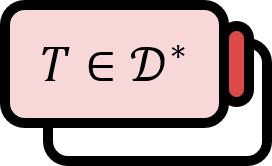Schwartz Space and Schwartz Functions
Definition
The set of functions $\phi : \mathbb{R}^{n} \to \mathbb{C}$ that satisfy the following two conditions is called the Schwartz space, denoted by $\mathcal{S}(\mathbb{R}^{n})$. An element $\phi$ of the Schwartz space is called a Schwartz function.
(a) $\phi \in $ $C^{\infty}$
(b) For any multi-index $\alpha$, $\beta$, the following holds: $\left| \mathbf{x}^{\beta}D^{\alpha}\phi (\mathbf{x}) \right| <\infty$. Here, for $\beta=(\beta_{1}, \beta_{2},\dots,\beta_{n})$,
$$ \mathbf{x}^{\beta}=x_{1}^{\beta_{1}}x_{2}^{\beta_{2}}\dots x_{n}^{\beta_{n}} $$
(b) can be rewritten as:
$$ \mathbf{x}^{ \beta}D^{\alpha}\phi (\mathbf{x})\to 0 \text{ as } \left| \mathbf{x} \right|\to \pm \infty \quad \forall \alpha, \beta $$
Description
It defines the multiplication, differentiation, and various operations of distributions on test functions. With this sense, one could attempt to define the Fourier transform of distributions as follows:
$$ \widehat{T^{}}(\phi):=T \big( \hat{\phi} \big) $$
However, even if $\phi$ is a test function, it may not have a compact support and thus may not qualify as a test function. Therefore, the Fourier transform of a distribution might not be well-defined. Thus, to ensure the Fourier transform is well-defined, the test function space was extended to newly define the Schwartz space.
Looking at (a), unlike the condition for test functions, there’s no requirement for compact support. This is why condition (b) was added. Test functions, having the strong requirement of compact support, did not need to impose restrictions on the shape of functions. In contrast, since Schwartz functions do not need to have compact support, condition (b), which ensures the function values decrease more rapidly than any polynomial at the ends of the real line, becomes necessary. Indeed, showing that the test function space is a proper subset of the Schwartz function space demonstrates it has been properly extended.
$$ \mathcal{D}(\mathbb{R}^{n}) \subsetneq \mathcal{S}(\mathbb{R}^{n}) $$
Properties1
Let’s say $\phi, \psi \in \mathcal{S}(\mathbb{R}^{n})$.
- $\mathcal{S}(\mathbb{R}^{n})$ is a vector space.
- $\mathcal{S}(\mathbb{R}^{n})$ is closed under multiplication. $$ \psi \phi \in \mathcal{S}(\mathbb{R}^{n}) $$
- $\mathcal{S}(\mathbb{R}^{n})$ is closed under multiplication by the polynomial $P$. $$ P\phi \in \mathcal{S}(\mathbb{R}^{n}) $$
- $\mathcal{S}(\mathbb{R}^{n})$ is closed under differentiation. $$ \phi^{\prime} \in \mathcal{S}(\mathbb{R}^{n}) $$
- $\mathcal{S}(\mathbb{R}^{n})$ is invariant under translations and multiplication by the complex exponential function. $$ \phi (x+y), \phi (x)e^{i\xi \cdot x} \in \mathcal{S}(\mathbb{R}^{n}) $$
- Schwartz functions are integrable. $$ \int\limits_{\mathbb{R}^{n}} \left| \phi (x) \right| dx \lt \infty $$
Robert Strichartz, A Guide to Distribution Theory and Fourier Transforms (1994), p30 ↩︎
